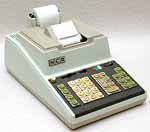Home > Calculator Technology > Calculator Electronics
Calculator Electronics
The
Calculator and the Microprocessor
In the late 1960s Intel Corporation, then a new company at the forefront of semiconductor memory development, took on a contract from Busicom of Japan to produce a series of integrated circuits for the varying specifications of a
new range calculators.
Ted Hoff proposed that they should produce one general purpose calculation chip, and that the varying specifications should be achieved by using different operating programs stored in Read-Only Memory
(ROM) chips.
Federico Faggin pushed the design of the chips forward and in 1971 Intel introduced the 4004 4-bit processor which was used in the Busicom calculators, together with the 4001 (2,048-bit ROM memory), 4002 (320-bit
RAM memory), and 4003 (10-bit shift register).
The journal "Electronic Design" reported in February 1971 "At Intel Corp., Mountain View, Calif., a single-chip central processor unit is being tested for a Busicom, USA,
calculator. It will be used with custom ROMs and RAMs for programming and memory."
Intel immediately realised that this chip could have a wide range of uses in all kinds of equipment, depending only on the program used, and
were soon pushing this "microprocessor" to the electronics industry. From this, over the next 30 years, were developed the 8008, 8080, 8086, 80286, 80386, 80486, and Pentium processors. It is notable that Pentium processors still
implement the Binary-Coded Decimal (BCD) instructions that the 4004 used for the calculator arithmetic.
Click on the picture to go to the page with more details.
Texas Instruments had been thinking along similar lines and produced their own microprocessors in competition.
One of their developments was the TMS 1000 series of 4-bit "One-Chip Microcomputers". Now generally known as
Microcontroller chips, these integrate the processor, the ROM, and the RAM all on the single chip. Under various part numbers (depending on the program in the ROM) these were used in a variety of calculators in the mid 1970s, such
as the Speech+ speaking calculator for the blind.
Click on the picture to go to the page with more details.
Calculator Technology
Calculator Electronics
Vintage Calculators
Text & photographs copyright, except where stated otherwise, © Nigel Tout 2000-2026.

